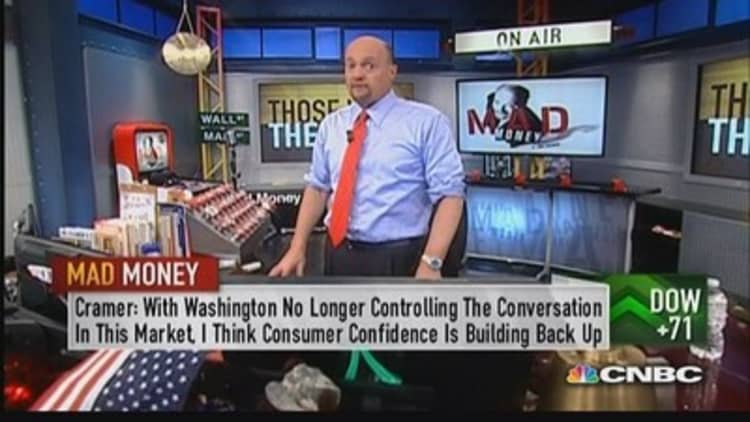Stocks rallied past two psychological barriers Monday morning, pushing the over 16,000 and the Standard & Poor's 500-stock index beyond 1,800 for the first time, as investors still saw opportunities in the market.
Those round numbers were not important in themselves. Adjusted for inflation, the market remains below the peak it reached earlier in the decade. And by the end of the day, the market averages had retreated somewhat, with the Dow closing up slightly and the S&P reversing course and ending down.
But those easily remembered strings of zeros represented new benchmarks for a stock market that has already soared more than 160 percent since it hit bottom in March 2009. And they might entice investors who have been late to the party to enter it now, even if prices are no longer as cheap as they were a few years ago.
More from The New York Times:
Regulators See Value in Bitcoin, and Investors Hasten to Agree
Obama'sFirst-Term Finance Team: Where Are They Now?
GeneralElectric Finally Gets Past the Jack Welch Era

"A number like Dow 16,000 doesn't mean anything in isolation," said Jeffrey Kleintop, chief market strategist at LPL Financial in Boston. "But it helps to create a behavioral bias that gets more individual investors to come back into the market. It's kind of a flag, telling people, 'Don't miss this,' and more people who have been sitting on the sidelines will be likely to buy stocks."
As people open their 401(k) and mutual fund statements these days, the numbers have generally been looking much better. That's not just because recent returns have been strong but also because with the passage of time, the horrendous declines of early 2008 have dropped out of the calculations of five-year stock returns. Perhaps partly because of this, there is some evidence of a modest surge into stock mutual funds recently.
While individual investors have often been skittish about the stock market, a consensus of professional strategists became convinced months ago that compared with bonds, stocks were a good bet. That view is still widely held, with some caveats.
(Read more: 7 reasons why Cramer embraces selloffs)
" 'Don't fight the Fed' is one of the oldest adages on Wall Street," noted David A. Rosenberg, chief economist and strategist of Gluskin Sheff in Toronto. He says the swelling Federal Reserve balance sheet and the return of the stock market are highly correlated, with Fed officials deliberately pushing investors into buying stocks.
Mr. Rosenberg, often thought of as a "permabear" because of his long-term gloomy outlook, is now cautiously bullish on many stocks and negative about the prospects for the bond market."The long rally in bonds is over," he said in a recent commentary.
On Monday, the yield on the Treasury's 10-year note fell to 2.67 percent from 2.70 percent late Friday, while its price increased 11/32, to 100 24/32.
(Read more: After sky-high gains, is the market rally sustainable?)

One problem, however, is that a range of valuation models show that stocks are relatively attractive — with"relative" being the key word — as long as interest rates remain very low.Corporate profits are rising, but not rapidly enough on their own to justify big increases in stock prices.
The direction of the bond market is therefore critically important to stock investors, who were reassured by testimony last week from Janet L. Yellen, suggesting that if she is confirmed as the Fed chairwoman, the central bank will continue to be accommodative as long as the economy remains weak.
A sharp strengthening of the economy, and a tapering of the Fed's $85 billion in monthly bond purchases — a policy known as quantitative easing — does not seem likely in the next few months, many strategists said.
But some analysts are bullish without deep conviction. Matt Paschke, for example, co-manages both bullish and bearish portfolios for Leuthold Weeden Capital Management in Minneapolis,including the Grizzly Short fund and the Leuthold Core fund. Over all, he said,despite stretched valuations in the stock market his firm remains "cautiously bullish," largely because the fixed-income market looks so unattractive.
(Read more: Some scary numbers in the jobs data)
"There are two schools of thought on stock valuation," he said. "One says you should only buy stocks when they're cheap. The other says I need to put my money somewhere, so where should I put it? If you look at it that way, stocks are the only game in town, and that thought will probably make us and some other market participants stick around a little longer than we might like because there's nowhere else to go."
On a valuation basis, he said,the stock market isn't particularly appealing. While it's not in extreme bubble territory, he said, the S.&P. 500 is fairly richly priced right now. Going back to 1940, he said, industrial stocks in the index are trading 11.8 times price to cash flow, which puts them in the 83rd percentile, on a historical basis.
"You'd like to see them in the middle third or lower, but they're in the top third, as far as valuation goes."
(Read more: Cramer: Whole sector looks undervalued)

They are also very expensive — well into the 90th percentile on a historic basis — according to several other metrics, including price-to-sales and price-to-book ratios, he said. If stock market participants believed that the Fed was about to alter its policy — and bond yields were going to rise sharply in the near future — then there might well be a flight from the stock market, he said. "We're re-evaluating our position week to week," he said.
On Monday, the Dow closed up 14.32 points, or 0.09 percent, to 15,976.02, while the S.&P. 500 fell 6.65 points, or 0.37 percent, to 1,791.53. The Nasdaq composite index also fell, by 36.90 points, or 0.93 percent, to 3,949.07.
Tim Hayes, chief global investment strategist for Ned Davis Research in Venice, Fla., said that he expected global stock markets to remain in an upward trend for the next few months. But then, he said, "with valuations getting stretched and monetary conditions becoming less favorable, there are, unfortunately, high probabilities that there will be a serious correction next year."
(Read more: Buffett Still Sees 'Good Value' in Stocks)
Longer term, however, Mr. Hayes said, once that battering is over, the bull market is likely to resume.
Mr. Kleintop said that for the market to keep climbing, it's important that "the economy start growing a little faster," adding, "I think it can do that."
Still, he said, it's quite possible that investors who jump into the market now might experience an immediate 10 to 15 percent decline, one that is probably overdue in a bull market of this duration.
"It would be unfortunate," he said, "if people who have stayed out of the market see the momentum, come in and get hurt. You'd hate to see that happen, but people should know that it could."
—By Jeff Sommer of The New York Times.

